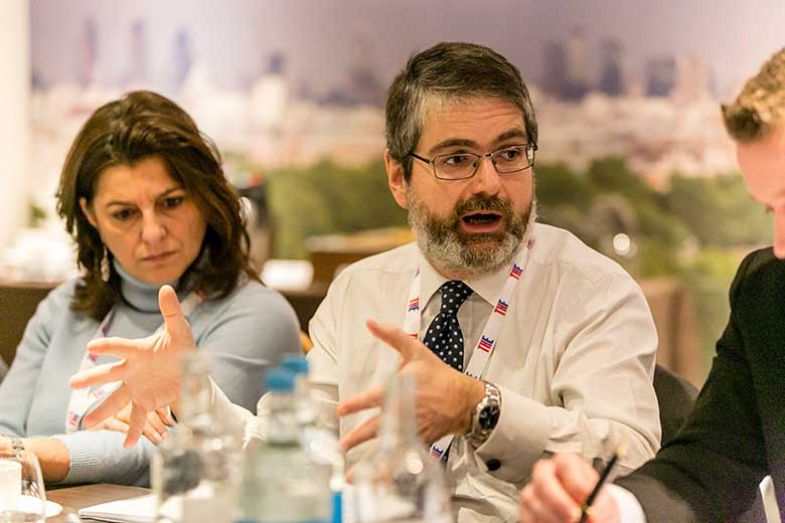
The best approaches to transforming UK universities in an uncertain market were discussed at a Times Higher Education and PA Consulting roundtable event
Uncertainty has become a permanent state of affairs in higher education and the departments feeling this most keenly in universities are those in charge of strategic planning. As part of Times Higher Education Live in November 2018, a group of senior leaders from UK institutions attended a roundtable meeting to discuss the challenges of their work. In light of external factors, such as Brexit and the outcome of the Augar review, they spoke about the practical steps they are taking to future-proof their institutions and how to navigate this journey.
The roundtable was chaired by THE’s news editor, Chris Havergal, and held in partnership with PA Consulting, whose higher education practice is working closely with a number of universities on transformation.
Paul Woodgates, higher education lead at PA Consulting, opened the debate by proposing that universities face three key decisions: whether their change programme should be driven from the top down or from below, how quickly it should happen, and how to engage staff, students and other stakeholders. “What dooms a transformation is failing to bring your community with you, so the decision about how you bring people on board is key,” he said. “This takes strong leadership from the top and service-by-service leadership throughout the organisation. You need a consistent narrative that links to your bigger vision, which is tough to do but really important.”
The planning role in universities has undergone considerable change in recent years, moving away from managing budgets and buildings to something more holistic and horizon-scanning. Many administrative roles now include “transformation” or “change” in their title to reflect this, as is the case for Chris Green, chief transformation officer at the University of Glasgow.
Discussing how he has helped bring university leaders on board with changes at his institution, he explained: “We interviewed 50 of our key people and asked them what they would transform and why. It’s about making it resonate for them and bringing them with you. I have no chance of bringing 8,500 people along but, if I can engage 200 or 300, then we have a chance of making it work.”
The panel agreed that approaches to managing change depended heavily on the circumstances or challenges of individual institutions. If there is a “burning platform”, such as radical cuts to the university budget or a staffing restructure, these changes often need to be led from above. If it’s about moving steadily towards a collective goal, this can be more iterative. “I think an agile development methodology works well,” argued Rosa Scoble, director of planning and policy at Brunel University.
“You start off with a draft of what you want to do and co-develop it with those involved. Set a framework for change and work within that.
“Going away and making a perfect plan is not going to work,” she added.
Chris Cobb, pro-vice chancellor and chief operating officer at the University of London, said that this approach also helped individual teams and departments to navigate change. “Some disciplines are happy to work alongside each other but others are not. “I think if you set out with a strategy, you have that framework and then, within that, each department works out what it’s going to do to move towards it,” he said.
Ian Matthias, higher education expert at PA Consulting, described this collective goal as “the North Star of strategy and objectives”, adding that “there are so many complications that it is never going to be a straight line”.
Paul Marshall, director of planning at Nottingham Trent University, suggested that significant changes, such as Victoria University in Australia’s move to a block teaching model, often require direction from the top, but that certain cultures may question it. “If an institution is innovative and comfortable in itself, then they can effect change from the bottom up. But if you’re in crisis, then, no.”
The UK higher education sector has already endured several years of policy shifts, greater marketisation and changes in students’ expectations – and the coming years are likely to be just as tumultuous, if not more so.
This means that these top-down, wholesale changes could become more common, said Julie Leeming, director of planning at St George’s, University of London. “We’ll see a reduction in the number of 18-year-olds and it will be a buyer’s market for applicants,” she said. “Organisations may suddenly find they have no money – how do we make teams realise there’s a lot going on and we have to deal with it?”
This is why it is so crucial to build a compelling case for change, added Susan Clucas, director of planning at Soas, University of London: “We’ve been providing management information to show what is going well and what’s not, and going through the insights with heads of department. Providing evidence is an important role for the planning team.”
How such teams communicate university change strategies has a huge influence on their success or failure, the panel found. So, is it more realistic to accept that you will never bring everyone along? “There’s a point where you say, ‘I’m sorry you’re unhappy’,” said Dr Scoble. “From my perspective, it’s about credibility, especially with the academic community. That way, they see you’re on the side of the institution.”
One approach to this is to create “champions” around the university. These could be heads of department or simply those who have an influential voice, said Ms Clucas.
Mr Marshall advocated setting out negotiables and non-negotiables, not forgetting the student body. “Any transformation we do will have a direct impact on them, even if it doesn’t come to fruition until after they’ve left. Engaging with students’ unions can be successful in bringing their voice to the transformation,” he said.
The pace of change will also depend on the specific goals and appetite for change of each institution – as will how their success is measured. What’s crucial, argued Mr Green, is that it is “a conversation, a narrative – if you leave measuring success to the end then you’ve failed, and no one will believe you’ve delivered what you delivered”.
Finally, it is important to understand that reaching the goal set out in your strategic plan is not just about the numbers. “There’s a balance to be struck between the financial impact and the impact on student experience – academic and non-academic,” said Mr Marshall. “This is not just about efficiency, it’s a cultural change, too.”
The panel
Chris Havergal, news editor, Times Higher Education (chair)
David Bryan, director of strategic planning, De Montfort University
Susan Clucas, director of planning, Soas, University of London
Chris Cobb, pro-vice chancellor and chief operating officer, University of London
Chris Green, chief transformation officer, University of Glasgow
Julie Leeming, director of planning, St George’s, University of London
Paul Marshall, director of planning, Nottingham Trent University
Ian Matthias, higher education expert, PA Consulting
Rosa Scoble, director of planning and policy, Brunel University
Paul Woodgates, higher education lead, PA Consulting
More education insights from PA Consulting.
Join the THE Live mailing list here for all the latest THE Live news and exclusive offers.
























